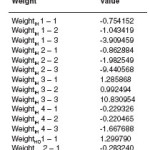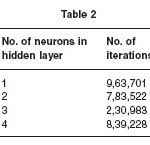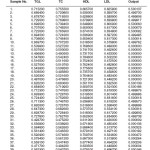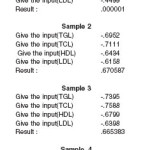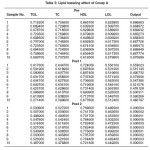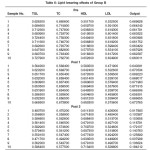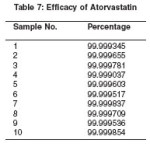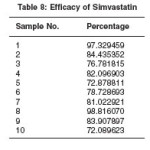An Intelligent System for the Characterization of Hyperlipidemic Blood and a Comparative Study on the Efficacy of Statins
S. Djodilatchoumy1, N. Rama2 and S. Gunasekaran3
1Department of Computer Science & Applications, Pachaiyappa’s College, Chennai - 600 030 (India)
2Department of Computer Science, Presidency College, Chennai - 600 005 (India)
3Spectrophysics Laboratory, Pachaiyappa’s College, Chennai - 600 030 (India)
Article Publishing History
Article Received on :
Article Accepted on :
Article Published :
Article Metrics
ABSTRACT:
Elevated lipid level is supposed to be one of the main risk factors for cardiovascular diseases. Therefore lipid lowering is one of the major target in cardiovascular treatment and prevention. Hence hyperlipidemic blood has to be identified and lipid level has to be lowered. Atorvastatin and simvastatin are the lipid lowering agents, they lower the low density cholesterol. For the characterization of hyperlipidemic blood, the FTIR spectra of blood sera of 20 healthy people and 20 hyperlipidemic patients of the same age group were recorded and fed as input to our system.To study the efficacy of statins, the FTIR spectral data of blood sera of the 20 hyperlipidemic patients of the same age group and blood group were recorded and fed as input to our system. Our system is trained to distinguish between the healthy and hyperlipidemic blood. Some remarkable differences are identified by our system. Both the statins were well tolerated and it is concluded from the results that Atorvastatin is more efficacious than simvastatin in modifying lipids in patients with hyperlipidemia and a high coronary heart disease risk. FTIR spectroscopy allows accurate lipids concentration determination. The results obtained from our System are well supported by both spectroscopic data and clinical data. Since our system is trained to distinguish the hyperlipidemic blood with the fine details of FTIR spectra, it can improve the diagnostic accuracy and rate of cardiovascular treatment and also it can analyze the efficacy of statins at a faster rate with more accuracy.
KEYWORDS:
Lipids; hyperlipidemia; atorvastatin; simvastatin; Efficacy of statins
Copy the following to cite this article:
Djodilatchoumy S, Rama N, Gunasekaran S. An Intelligent System for the Characterization of Hyperlipidemic Blood and a Comparative Study on the Efficacy of Statins. Orient. J. Comp. Sci. and Technol;1(1)
|
Copy the following to cite this URL:
Djodilatchoumy S, Rama N, Gunasekaran S. An Intelligent System for the Characterization of Hyperlipidemic Blood and a Comparative Study on the Efficacy of Statins. Orient. J. Comp. Sci. and Technol;1(1). Available from: http://www.computerscijournal.org/?p=2034
|
Introduction
Hyperlipidemia is a risk factor for coronary heart disease (CHD). Clinical studies have shown that lowering elevated serum total cholesterol levels
(TC) and particularly low density lipoprotein cholesterol(LDL) levels, reduces the frequency of coronary morbidity and deaths, whereas high serum level of high density lipoprotein cholesterol (HDL) protect against CHD. Therefore hyperlipidemic blood has to be identified and lipid level has to be lowered for cardio vascular treatment and prevention (A-D).
Neural network (NN) processes information in a similar way the human brain does. To capture the essence of biological neural systems, an artificial neuron is defined as follows:
It receives a number of inputs. Each input comes via a connection that has strength (weight), which corresponds to synaptic efficacy in a biological neuron. Each neuron also has a single threshold value. The weighted sum of inputs is formed, and the threshold subtracted, to compose the activation of the neuron. ´ The activation signal is passed through an activation function to produce the output of the neuron.
The NN is composed of a large number of highly interconnected processing elements (neurons) working in parallel to solve a specific problem. NN learns by examples. It can be trained according to our need. The examples must be selected carefully (H).
Even though investigations on characterization of hyperlipidemic blood and efficacy
of atorvastatin and simvastatin have been done by many, not much work is done on automation of this investigation. In cardiac analysis it is found that TGL, TC to HDL ratio and LDL to HDL ratio are good indicators of potential cardiac problems (E). The goal of this study is to design a system that can identify whether the given blood sample is hyperlipidemic or not, across the dose range on TC, HDL, LDL, triglycerides(TGL) and also to examine prospectively the effects of atorvastatin and simvastatin in patients with hyperlipidemia in the statin therapies, using the system which is already trained to identify the hyperlipidemic blood (F,G).
Material and Methods
For the characterization of hyperlipidemic blood, the FTIR spectra of blood sera of 20 healthy people and 20 hyperlipidemic patients of same age group were recorded and fed as input to train our system (F) which is a three-layer feed-forward backpropagation network. During the training iteration of our System, we modified the weights at the output layer and then we proceeded backwards on the hidden layer to reach the input layer (G). Our NN
consists of 3 layers namely (i) input layer with 4 neurons each corresponding to TC, HDL, LDL, TGL (ii) hidden layer with 3 neurons and (iii) output layer with 1 neuron. The value of the output neuron varie.
from .5 to 1 for the hyperlipidemic blood and 0 to < .5 for the healthy blood (value 0 indicates the most healthy blood and value 1 indicates the most diseased blood). The calculated Weight IH x–y which is the strength/weight of the connection between unit x in the input layer and unit y in the hidden layer and Weight HO x–y which is the weight of the connection between unit x in the hidden layer and unit y in the output layer are given in Table 1
The learning parameters ‘eta ‘component that is the gradient descent and ‘alpha’ component that is a ‘momentum’ term which effectively keeps a moving average of the gradient descent weight change contributions, were carefully chosen to speed up the training(I). 40 training samples were repeatedly fed to the NN in a random order for each iteration to minimize the weight oscillation.
To study the efficacy of statins, the blood samples were collected from the adult patients with their consent. Twenty patients of the same age group and blood group were chosen for the investigation. The patients were divided into two groups A and B. To access the lipid lowering effects of the two statins, group A is prescribed with atorvastain and group B with simvastatin.
atorvastatin 20mg. (Aztor) and simvastatin 20mg. (Zocor) were taken once daily with the evening meal for a period of six months by patients of group A and B respectively. An interim and final check up was performed over a period of 3rd and 6th months respectively, after the treatment was initiated. Before the drug therapy, the FTIR spectra of blood sera of both the groups were recorded and the spectral data were fed as inputs to our system and the
outputs were noted down (pre-treatmental). To find the efficacy of atorvastatin and simvastatin, the FTIR spectra were recorded at regular interval of 3
months and the spectral data were fed as inputs to our System and the outputs were noted down (post treatmental) (A-G).
Results and Discussion
The maximum number of iterations that the input samples can be repeated for training is 1,000,000. Our System will stop learning when the error term
that is the difference between network’s actual output and the desired output is less than 0.000001 or when it reaches the maximum number of iterations, 1,000,000. Fixing the eta value and alpha value to 0.9, the network is trained by varying the number of neurons in the hidden layer (Table 2). We found that the system is trained effectively with 3 neurons in the hidden layer.
Our system is able to identify the training samples (40) correctly, the result of which is summarized in Table 3. It is also able to identify any
random sample correctly which is evidenced by Table 4.
In order to find the efficacy of atorvastatin and simvastatin, the outputs of pre-treatment (Pre), post-treatment1 (Post 1), post-treatment 2 (Post 2) for Group A are given in Table 5 and for Group B in Table 6. The % of efficacy of the statins is calculated using the formula (Pre-Post) / Pre * 100 and the
results are given in Table 7 and Table 8. It is concluded from the result that atorvastatin is more efficacious than simvastatin in modifying lipids in
patients with hyperlipidemia.
Conclusion
NNs are being used in the detection of various diseases. A variety of health-related indices can be monitored. The onset of a particular medical
condition could be associated with a very complex combination of changes on a subset of the variables being monitored in medicines. NNs have been used to recognize this predictive pattern so that the appropriate treatment can be prescribed. FTIR spectroscopy allows accurate lipids concentration
determination. The results obtained from our system are well supported by both spectroscopic data and clinical data. Since our system is trained to
distinguish the hyperlipidemic blood with the fine details of FTIR spectra, it can improve the diagnostic accuracy and rate of cardiovascular treatment and
also it can analyze the efficacy of statins at a faster rate with more accuracy.
Acknowledgment
We are indebted to Government General Hospital, Chennai, India for providing the blood samples of hyperlipidemic patients with their lipid profiles. We are grateful to Sophisticated Analytical Instrumentation Facility (SAIF), Indian Institute of Technology, Chennai, India for showing special attention in spectral readings.
References
- Comparing the efficacy and safety of atorvastatin and simvastatin in Asians with elevated low –density lipoprotein –Cholesterol – a multinational, multicenter, double – blind study, WuCC, Tanphar Chitr V, Hin AT, Suvone S, Lee YT, J Formos Med Assoc., 101(7): 478-87 (2002).
- Comparison of the efficacy and tolerability of policosanol with atorvastatin in elderly patients with Type II Hypercholesterolemia, Castano G, Mas R, Fernandez L, Illnacl J, Mesa M, Alvarez E et al, Drugs Aging , 20(2): 153-63 (2003).
- Analysis on Hyperlipidemic patients Blood Samples – Spectral and Statistical implications, S.Gunasekaran,T.S.Renuga Devi, Asian journal of clinical cardiology, 10(10): 14-19 (2008).
- Fourier Transform Infrared Spectroscopy for TSE diagnosis. http://www.healthnews. co.uk/showstory.asp?id=98788
- Nutri-Body for the health of your heart http:/ /www.nutribody.com
- The Role of Neural Networks in improvind the accuracy of MR Spectroscopy for the diagnosis of head and neck squamous cell
carcinoma, Ronald J. Gerstle, Stephen R. Aylward, Sharon Kromhour-Schiro and Suresh K. Mukherji, American Journal of Neuroradiology, 21: 1133-1138 (2000).
- An Introduction To Back-Propagation Neural Networks, Pete McCollum.
- Neural Networks, Christos Stergiou and Dimitrios Siganos. http://www.doc.ic.ac.uk/ ~nd/sur prise_96/jour nal/vol4/cs11/ report.html
- John Bullinaria’s Step by Step Guide to Implementing a Neural Network in C, John A. Bullinaria.

This work is licensed under a Creative Commons Attribution 4.0 International License.
